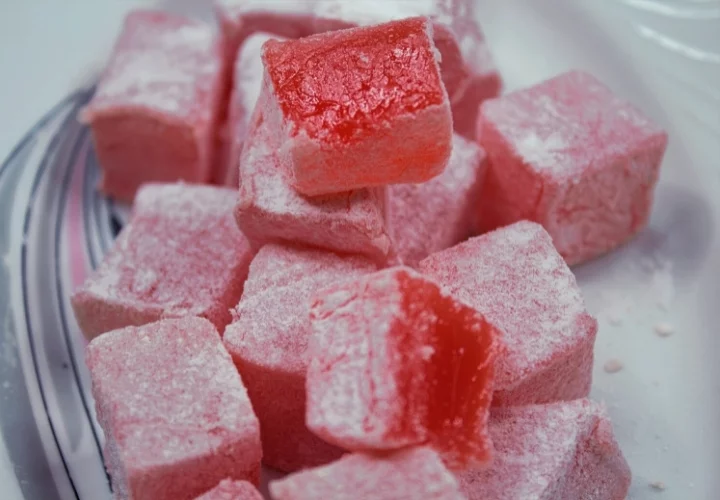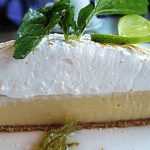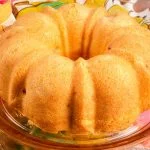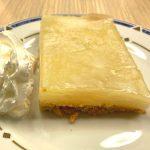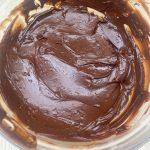This post may contain affiliate links
This traditional Turkish delight recipe from Narnia is as near to being perfect as a confectionary recipe can be thanks to trials and errors. Naturally vegan & gluten-free, “lokum” is the ideal combination of chewy and sweet. Continue reading to learn about Turkish delight’s unique history as well as all the essential advice and solutions.
I’ve spent a long time trying to get this recipe just right. The earliest tries were either stretched, lumpy, overly soft, or too chewy. A little later, I discovered that numerous Turkish delight recipe sites online were filled with people who, like myself, had experienced the same thing.
I’m confident in all the instructions and advice offered here after eventually perfecting the recipe (took around 5 attempts of numerous batches). It is a way less effort to spend an extra 5 minutes reading the instructions if you are going to spend two hours and many ingredients on a lokum preparation in order to prevent headaches.
Pay special attention to the temperature instructions, the starch addition, and the last stage doneness evaluation in particular.
What is Turkish Delight?
Turkish delight is a very well-known and extremely sweet candy from Turkey, as its name may imply. There, it is most frequently referred to as lokum, and its first iteration dates to the late 1700s.
Abdülhamit I, the Sultan of the Ottoman Empire at the time, is said to have had a sweet tooth for a softer confection than what was offered at his court. Being a wealthy guy, he called his candy makers and asked for soft candy to sate his sweet craving. Turkish Delight was then created.
The dessert, which is frequently offered as a welcome gift, was probably created by a candy maker by the name of Bekir Effendi. At the time, the sultan enjoyed his creation so much that he promoted him to the chief confectioner. The dessert is frequently provided with coffee or tea in Turkey.
Turkish delight is made by first heating sugar and water to create a sugar syrup, as is the case with many other gummy sweets. It is then thickened with cornstarch, making it distinct from other chewy candy.
According to Rory Macdonald, pastry chef at the Institute of Culinary Education, “it has a set gel sort of texture, which is really different from anything made with gelatin or agar-agar [a jelly-like material].” “It normally comes in a variety of tastes and is incredibly smooth and enjoyable to eat. Sometimes chocolate is used to hide it.”
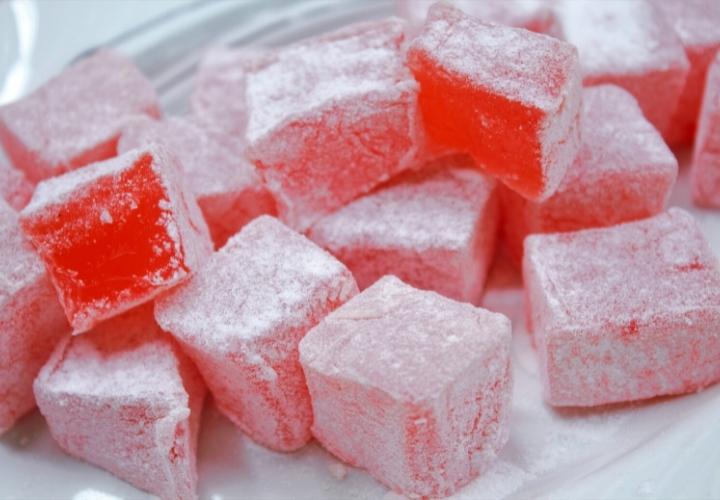
How does Turkish Delight from Narnia Taste?
The texture of plain Turkish delight is something between marshmallow, jello, and soft taffy, and it tastes quite sweet with a tiny tinge of caramel.
Most lokum is prepared with different ingredients, such as floral or fruit extracts and nuts. Rose-flavored Turkish delight from Narnia is the most popular sort and of course, the one we’re making today.
Why Was Turkish Delight Included in Narnia by C.S. Lewis?
Lokum was introduced to the West later in the 19th century when tourists who adored this unusual confection in Istanbul took cases of it back to Britain. In 1861, it was first introduced in England under the name “Lumps of Delight.” Thankfully, Turkish delight became the term that stuck.
The world was considerably different when C.S. Lewis began writing The Lion, the Wardrobe, and the Witch. Confectionery products were rationed in Britain due to World War 2. The allotment per person each month—if you could afford it, of course—was still half a pound of sweets and chocolate by the time the book was ultimately published in 1950.
The fact that Edmund Pevensie’s White Witch request is for a sweet that is nearly completely composed of sugar makes perfect sense in light of this. Something expensive and presently out of reach
Here’s another interesting detail about Lewis’s interest in Turkish culture: the Turkish word Aslan literally means “lion”!
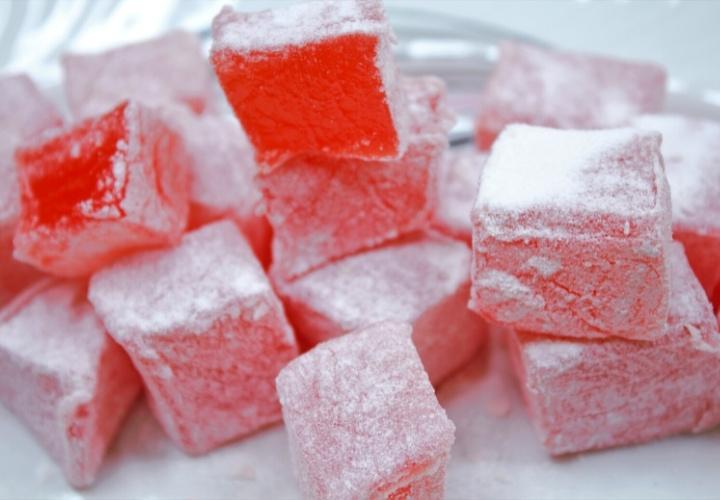
Is Turkish Delight Vegan?
The majority of the time, veganism and the absence of animal products make authentic plain Turkish delight possible. However, there are certain restrictions: since most sugar manufacturing plants still employ that method, it’s possible that the sugar used in them was filtered via bone char.
Be aware that there are a few unusual recipes online that call for the use of gelatin to solidify the dessert, but I wouldn’t classify such as lokum. In addition, some uncommon types include clotted cream (“kaymak”) sandwiched between layers of lokum; these must be consumed shortly after creation and are very hard to locate outside of Turkey.
However, suppose you do find yourself at a Turkish candy shop one day. In that case, you’ll notice that some types appear as like they must unquestionably include some dairy because they’re fluffy, frequently white or light in color, and occasionally referred to as “paşa” or “sultan” lokum.
Typically, they include soapwort extract instead of dairy products! This enchanted plant extract radically transforms Turkish delight. It could turn into the next aquafaba; therefore, I can’t wait to get my hands on it and try utilizing soapwort in meringues!
Turkish Delight from Different Countries
Turkish cuisine has expanded around the world as a result of the expansion of the Ottoman Empire, and many nations now have their own versions of various Turkish dishes. Here are a few nations with their own versions of the popular sweet.
Turkish Delight from former Yugoslav Countries: Turkish delight was introduced to this region by the Ottomans and is known as Rahat-lokum, Ratluk in Serbia, or lokum in Albania and the former nations of Yugoslavia. Traditionally, coffee is paired with it.
Turkish Delight from Bulgaria: Turkish delight is known as lokum (локум) in Bulgaria, where it is equally as popular as it is in Turkey. Since Bulgaria manufactures its own lokum, it is rarely imported.
Greek Turkish Delight -The Greek version of the dessert, called Greek loukoumia, is typically served with coffee. Mastic loukoumi is the most popular flavor in Greece, and it is readily accessible there.
Similar to loukoumi, akanes is a Greek treat that uses fresh goat’s milk butter as its flavoring rather than the fruit essence used in more widely consumed loukoumi.
When the area was under Ottoman administration, akanes was originally known as hakanes halva (derived from the Turkish words han and kaan, which were previously Mongolian phrases and used as titles for monarchs, connoting that the confection was reserved for royalty). Akanes is only created in the town of Serres.
Turkish Delight from Romania – Many of the Turkish phrases that started to be incorporated into the Romanian language were employed in a derogatory manner in an effort to undermine Ottoman power in Romania. Rahat, which is derived from the Arabic word rahat ul-hulkum and is used to describe Turkish delight in Romanian, also has the meaning “crap.” Rahat is still consumed in Romania and is also put into a variety of traditional pastries despite its twofold connotation.
Turkish Delight in North America – Turkish delight has been created in a variety of forms and with a wide variety of unique flavors by American enterprises since the 1930s. Some businesses call them rahat locoum, which is obviously derived from the Arabic term.
The Big Turk, a chocolate bar made by Nestlé in Canada, is made of Turkish delight and wrapped in chocolate.
Turkish Delight in Brazil: Delicia Turca, Bala de Goma Sria, Manjar Turco, and Bala de Goma rabe are the names for Turkish delight in Brazil. Arab immigrants to Latin America brought sweets with them.
Turkish Delight in Britain – Turkish delight is consumed in Britain as well as a few other nations, including Ireland, Australia, Canada, and New Zealand, in the shape of a chocolate bar called Fry’s Turkish Delight, which is Turkish Delight flavored with rose water and wrapped in chocolate. Many Turkish and foreign supermarkets, particularly in London and other large cities, carry Turkish delight.
Popular Turkish Delight Varieties
Rose Turkish Delight
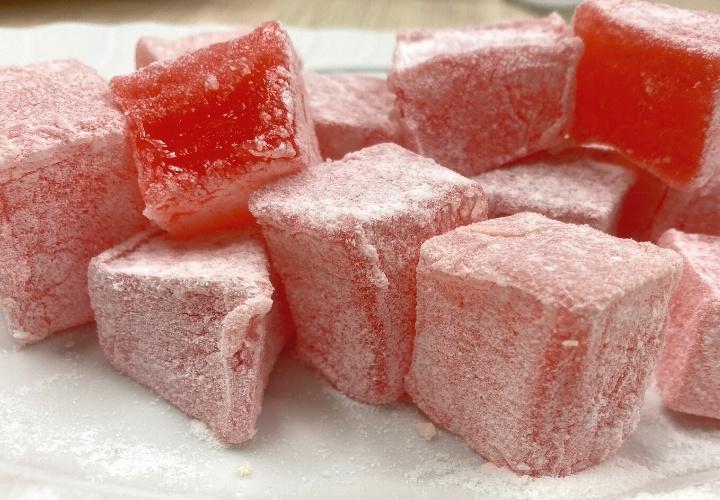
What could be a more opulent souvenir from a vacation to Istanbul than a box of Turkish delight with rose flavor? Step into the spice bazaars of Turkey, and you’ll find rolls of Turkish delight that have been sweetened with sugar and coated in dried rose petals, despite the fact that it is easily accessible in the traditional style of pink cubes that have been flavored with rosewater and dipped in icing sugar throughout many confectionery shops.
Pistachio Turkish Delight
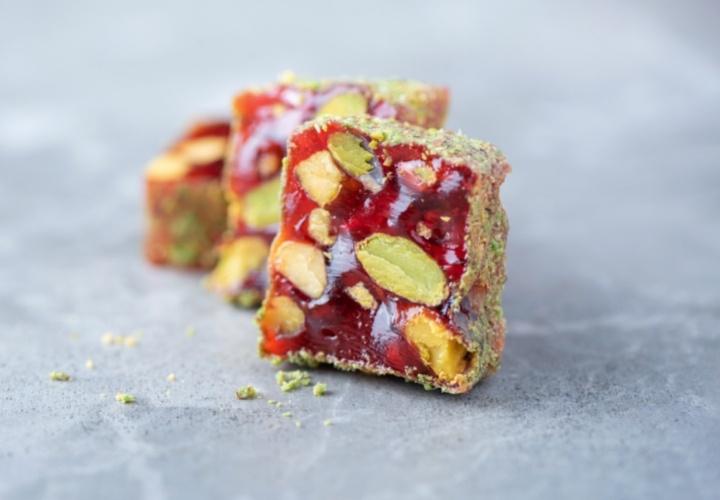
Given that Turkey is one of the world’s top producers of pistachio nuts, it is not unusual to see Turkish delight in cubes, rolls, and various flavors that have been generously packed or coated in these delectable and colorful green nuts.
Lemon Turkish Delight

Excite your taste buds by biting into some lokum with a zesty lemon flavor; it’s not only very refreshing, but it’s also one of the most traditional Turkish Delight flavors.
Pomegranate Turkish Delight
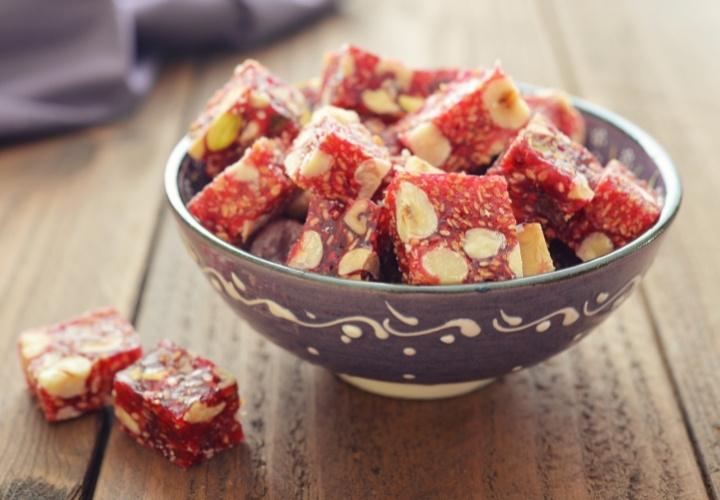
Turkey is a true “pomegranate heaven,” therefore, there are many foods with pomegranate or nar flavors to choose from, including molasses, beverages, tea, and, of course, Turkish delight. This is by far one of the most well-known flavors of lokum, sometimes covered in dried barberries or sliced pistachio nuts.
Coconut Turkish Delight
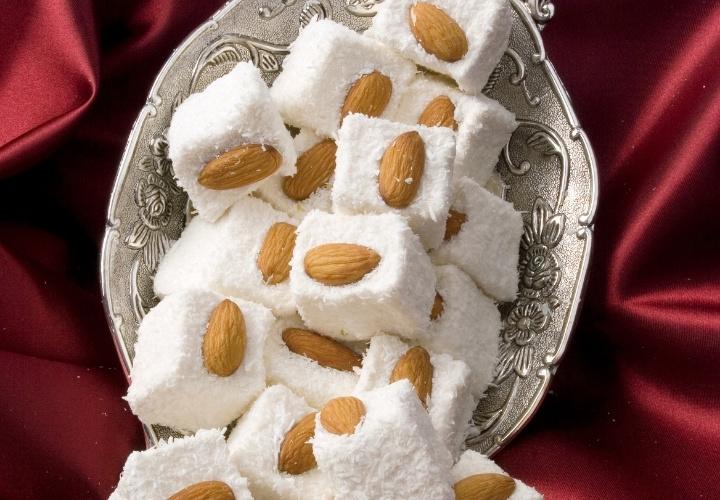
Turkish delight with coconut flavor and coating is such a soothing treat, and it comes in a variety of rolls with delectable fillings like chopped nuts and even Nutella!
Turkish Delight Recipe
Ok, time to make authentic Turkish delight from Narnia, but make sure to check the “Important Notice” section for troubleshooting and the FAQ section below the recipe.
Ingredients
Lokum ingredients:
- 2 cups of white sugar (400g)
- ¾ cup of water (for syrup) (180 ml)
- ¼ tsp of citric acid
- 8 TBSP of cornstarch (use more if required)
- 2 cups + 1/3 cup of water (for cornstarch)
- 2 tsp of rosewater
- 9-10 drops of red food color
Cutting ingredients:
- 4 TBSP of cornstarch
Dredging ingredients:
- ⅔ cup of cornstarch
- ⅓ cup of powdered sugar
Instructions
- Using a heavy-bottomed pan, combine citric acid, sugar and water. Stir till the sugar is completly dissolved.
- High heat should be used to bring the ingredients to a boil, then it should be simmered till the syrup hits 250°F. A candy thermometer will provide the most accurate readings, so be careful to modify this temperature for in your kitchen and keep a constant eye on the pan. Based on the heat output of your stove, this should take 15 to 30 minutes.
- Prepare the cornstarch mixture in the meantime by combining cornstarch and water in a jar. Shake ferociously with the lid on until no visible cornstarch lumps are present. Alternately, carefully whisk in a different bowl.
- When the syrup hits 250°F, turn off the heat and slowly pour the cornstarch mixture that has just been mixed into the pan while still whisking.
- Turn the heat down to medium-low and keep whisking till gelatin is formed after all of the cornstarch has been added. The mixture should thicken in a few of minutes.
- After it has thickened, reduce the heat to a simmer and stir it occasionally to keep it from adhering to the bottom. The thickened liquid can splatter, so use caution. Keep doing this for a couple of hours.
- Spray a small amount of neutral oil in a mold for Tukish delight and spread it around nicely.
- Look for a medium-dark color of amber and a moderately thick—but not gloopy—texture to determine when the Turkish delight has finished cooking. The combination is generally nearly finished by one and a half hours. This period of time will vary depending on a number of elements, including the size of the pan, how much of each ingredient is used to prepare lokum, and the thermal efficiency of the stove. Make sure to evaluate by color and thickness because it can take up to two hours or more.
- Add the rosewater and food coloring after removing the Turkish delight from the heat. Mix, pour into the container, and leave at room temperature for at least five hours; ideally, leave it for a whole day, especially if it’s summer and high humidity.
- Add cornstarch to the container the following day, then slice a strip off the edge so you can take out the entire slab. Cut Turkish delight into cubes after adding extra cornstarch to the surface.
- After being cut into cubes, coat them with a combination of powdered sugar and cornstarch.
- Turkish coffee with water on the side, which is how it is often consumed in Turkey, should be served to enhance the Turkish delight experience. It’s also very common to sandwich the lokum between simple biscuits like Biscoff (also known as Petibör in Turkey). These are excellent Christmas presents as well. Enjoy!
The Turkish Delight Recipe: Important Notes
This is the recipe’s most essential component. I can’t stress enough how important it is to use a candy thermometer, but if you’re determined to go without, you may do the cold water check. We want the syrup to form a firm but pliable ball between your fingers after it has reached the “hard ball” stage, which occurs when you pour a tiny quantity of the boiling syrup into cold water.
Due to the high concentration of sugar in the syrup, the heating rate rises quickly after reaching roughly 220°F, therefore you must act quickly. Up to 260°F is OK, but if you exceed this temperature, the food will cook for more than two hours and turn hard candy without your knowledge.
If you’re using a candy thermometer, it wouldn’t hurt to test it on some boiling water to be sure it functions properly. Be careful to also take your kitchen’s altitude into account. For instance, if you’re preparing this in Colorado Springs (6035 ft), 240°F rather than 250°F is what you want. Water boils at 1°F lower altitude for every 500 feet of elevation gain.
Ensure that you stir gently after gelatin starts to form. Any vigorous whisking might break up the starch chains, resulting in a consistency that is thinner. However, if cornstarch gels, a slight thinning is normal after the first thickening.
Sometimes people would rather use plastic wrap than oil to line the container. While doing so will aid in eliminating the lokum slab, the surface will be covered with countless wrinkles. Consequently, I don’t like it.
Share the image below to your Pinterest board if you like this Turkish delight from Narnia recipe!
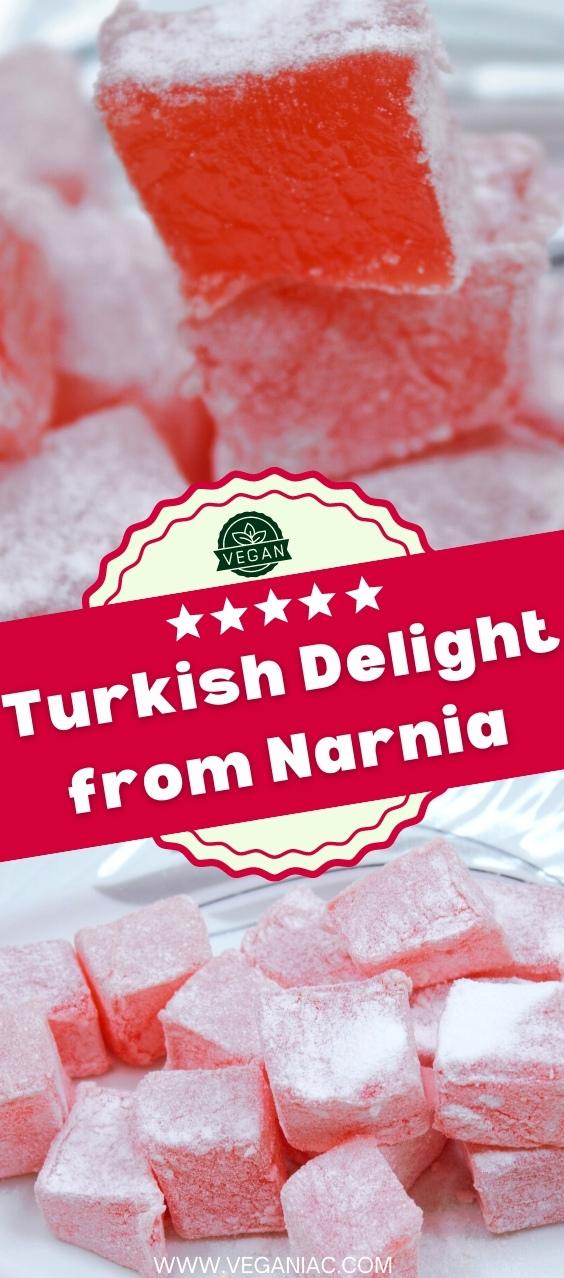
Storing Turkish Delight from Narnia
Turkish delight keeps incredibly well in storage. Two days after cooking lokum, in my opinion, is the ideal time to eat them. This allows the subtle chewiness ample time to develop.
I advise putting them in the fridge coated with all of the remaining cornstarch & powdered sugar mixture from dredging after the first drying out. Be sure to reheat Turkish delight at room temperature before serving.
Several warnings about storing Turkish delight
If all went according to plan, the final treats should contain no more than 15% water. These treats can be kept in the fridge or at room temperature in a dry place away from direct sunlight for several months. I’ve even eaten Turkish delight that was months old that got buried in the refrigerator; it was still good to eat, but it wasn’t as soft. All this implies, that after a few months, lokum’s sensory properties will start to decline.
The lokum needs to be consumed immediately, ideally within a week, if they came out more watery than this (possibly because the syrup wasn’t heated to a firm ball, the mixture was whisked aggressively after gelation, or the heat was turned off too early).
Since this kind of lokum will have a higher tendency for impurities, which may bring food-borne illnesses, keep them in the fridge coated with all the remaining starch & powder sugar mixture from dredging in an airtight container.
In case your Turkish delight contains nuts, keep it in the fridge.
FAQs on Turkish Delight from Narnia
Turkish delight not setting, what can I do?
It is extremely likely that one or more of the following occurred:
- the syrup was not raised to a sufficient temperature at the start;
- the final mixture was removed from the heat far too soon when the water content was still far too high.
- by mistake, too much acid (lemon juice, citric acid, or cream of tartar) or too little starch was added.
- the mixture was whisked too violently after gelation, causing the starch molecules to dissolve.
Sadly, there’s no method for returning it to its original texture, especially if you don’t understand what went bad. You may add pectin to solidify the mixture at this point to prevent wasting ingredients, but it won’t be a true Turkish delight.
Is cream of tartar required for original Turkish delight?
No, unless you’ve got citric acid or lemons. cream of tartar substance (Potassium bitartrate ) prevents sugar crystals in the same way as citric acid does in this recipe.
How can I replace citric acid in lokum with lemon juice?
1 tbsp lemon juice is about equivalent to 1/4 tsp citric acid. This will, however, vary depending on the lemon, as each has a varying quantity of acid. Also, contrary citric acid, lemon juice will almost certainly provide taste to your Turkish delight.
How can lumps in Turkish delight be removed?
From my knowledge, the phase where lumps are most likely to form is when you combine cornstarch and syrup, especially when the starch is supposed to be heated separately beforehand. This may be fully avoided by gradually adding starch dissolved in water into your syrup (preferably, shake rapidly in a container to eliminate any clumps).
If you are reading this when a lumpy mixture of lokum is already simmering on the stove, the answer will depend on whether or not you can really separate each lump one at a time. Start afresh and you’ll be pleased you didn’t waste another two hours on the job if you have, let’s say, more than 25 of these lumps. You should try to identify them if you can, then go on after that.
What temperature should Turkish delight be cooked at?
Ideal temperatures fall between 260 and 250 degrees Fahrenheit. The texture will be somewhat softer at the lower limit and chewier at the higher limit. Because it’s so simple to heat the mixture past the “hard ball” stage, I advise sticking to a temperature of 250°F. There is virtually no turning back from hard candy, however if you’re an expert, feel free to aim for 260°F right away.
Is it possible to prepare Turkish delight without a candy thermometer?
Certainly, you can if you are acquainted with and comfortable assessing the recipe’s steps using the cold water test. However, if a syrup reaches 220°F, temperature control becomes far more difficult due to the decreasing quantity of water in the mix.
This implies you must be incredibly fast with the cold water test; else, you risk warming to above 260°F and obtaining hard candy without noticing it for 2-3 hours.
Can I use another starch instead of cornstarch to make Turkish delight?
There isn’t an ideal solution. This is due to the fact that each variety of starch is unique and has its own individual ratios of starch molecule chains termed amylose and amylopectin, which lead to varied properties such as variable gelation thermal gradients, and texture, or heat stability.
Potato starch, for instance, contains a high number of linked phosphate groups, which causes starch chains to resist one another. This implies that it does not coagulate properly when cooled, which is important when producing Turkish delight. Overall, I would choose arrowroot starch as the best option if necessary.
Is Turkish Delight Gluten-Free?
Absolutely, typical plain lokum is gluten-free 99.9% of the time. The genuine formula, which almost all producers use, contains only five simple ingredients: water, sugar, citric acid, cornstarch, and occasionally cream of tartar. Prior to the introduction of cornstarch in the nineteenth century, however, Ottoman confectioners utilized wheat flour in Turkish delight recipes.
If you suffer from celiac disease or extreme gluten sensitivity, ask the supplier about all of the contents before purchasing packaged items. It is also worth noting that cross-contamination in the kitchen may be an issue for individuals in the same group.
Which sort of Turkish delight is the best?
This is all up on your preferences, but If you ask me, I will always go for the classic rose—also, orange, or double-roasted hazelnut/walnut lokum.
If you’re creating it yourself and know you won’t like, rose because it’s too perfumey, consider a citrus flavor like orange or something more recognizable like vanilla and cinnamon. If you’re going to buy online, acquire a variety pack and test them all!
